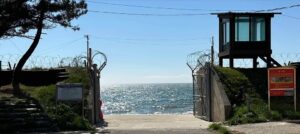
The Threat Comes from the Sea
On the South Korean island group of Yeongpyeong, people experience firsthand how often North Korea provokes the neighboring country. Just three kilometers separate the islands from the North. How do they live with the nearly daily artillery bombardments?
Twice a day, a ferry leaves from Incheon on the west coast of South Korea towards the Yeongpyeong Islands. It’s about a two-hour journey to the largest one, Daeyeongpyeong.
The island is only seven square kilometers, strategically important for the democratic South, as just a few kilometers away, islands belonging to North Korea emerge from the sea.
Bunkers, tunnels, and many soldiers
Daeyeongpyeong thrives on the military. About a third of the 2,000 people on the island are soldiers or military personnel. Those who visit the observation platform in the middle of the island can see camouflage-colored tunnels everywhere, with an occasional bunker here and there.
Inside the island cafe, hundreds of post-it peace doves and hearts in yellow and purple adorn a mesh wall. Soldiers and their loved ones have written wishes and messages, expressing their love and hope for peace. A de facto peace between North and South Korea has not existed since the end of the war in 1953, only an armistice.
Due to the cafe’s exposed location on a hill, it must close daily at 5:00 p.m. Young Ae stands relaxed behind the espresso machine. “We always hear when the North conducts military exercises,” she says. “Sometimes it worries me briefly, but that feeling quickly passes, and everyday life resumes.”
Taking refuge in the shelter bunkers
Young Ae recalls having a major scare at the beginning of January when 200 artillery rounds landed in the buffer zone, triggering an alarm on Daeyeongpyoeng, prompting people to seek safety. She spent three hours in the shelter bunker afterward, pondering why people in the rest of South Korea can lead carefree lives while they cannot.
Events in January did not bother Park Hee Sook. She points out the shelter bunker below her house, with the steel door left slightly ajar. At least the anteroom is open, with neatly aligned pairs of slippers on a shelf.
She assesses the risk of an attack not being greater there than anywhere else. “South Korea is a small country, and we are nowhere safe.” She wonders why North Korea would target a small island like hers rather than the mainland and Seoul.
Despite this, she vividly remembers a much more serious incident on Daeyeongpyoeng. In the fall of 2010, the North responded to military exercises by the South with artillery fire. Several houses were set ablaze, four people died, and eighteen were injured. Park Hee Sook moved to the mainland for three months following the incident and says she still flinched at every noise afterward.
Preparing for emergencies
The island has a total of seven shelter bunkers equipped to provide all residents with supplies for at least half a day. Lee Han Byul, seconded to Daeyeongpyoeng for two years from the city administration, leads a tour of one of the bunkers for 150 people.
Gas masks hang in one room while emergency beds are in the next, alongside various food supplies, a hi-fi system for TV and radio, and two gray telephones – one for island residents and another for military communication – and a satellite phone.
Lee Han Byul believes that Daeyeongpyeong is well-prepared for a potential attack. The navy conducts regular training, with many military bases in the North and even a self-propelled gun. In an emergency, a missile can even be fired northward.
Regular evacuation drills
In the event of a crisis aiming to evacuate residents from the island as quickly as possible, drills are regularly conducted every three months with voluntary participation.
About a dozen people followed the call one morning, boarding a hovercraft at the port. As the ship moves away, the Korean women in the front row take turns looking left and right, engaging in conversation on removing stains from laundry to get them white again. They leave the talking to the men when it comes to discussing with journalists. The men are relatively quiet, but one of them mentions feeling reassured by the drill, even if the group only circumnavigates their island within 20 minutes.